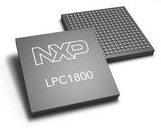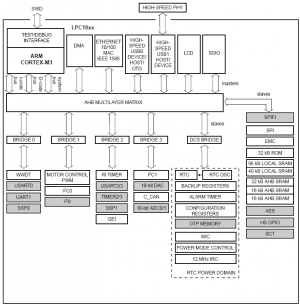
Novinka:NXP: ARM® Cortex™-M3 - LPC1800
(Kategória: Semiconductor-ZONE)
Zaslal EdizonTN
20.09.2010-11:13
Spoločnosť NXP predstavila na priebiehajúcom podujatí ESC Boston 2010, novú radu ARM CORTEX-M3 mikrokontrolérov - LPC1800.
Vlastnosti
Blokové zapojenie

Cena
Momentálne sú dostupné len vzorky.
Odkazy
LPC18xx series device Homepage
LPC18x0 Datasheet

Distribúcia
viď. Adresár
Táto novinka je z mikroZONE
( http://www.mikrozone.sk/news.php?extend.747 )
(Kategória: Semiconductor-ZONE)
Zaslal EdizonTN
20.09.2010-11:13
Spoločnosť NXP predstavila na priebiehajúcom podujatí ESC Boston 2010, novú radu ARM CORTEX-M3 mikrokontrolérov - LPC1800.
Vlastnosti

- Processor core
- ARM Cortex-M3 processor, running at frequencies of up to 150 MHz.
- ARM Cortex-M3 built-in Memory Protection Unit (MPU) supporting eight regions.
- ARM Cortex-M3 built-in Nested Vectored Interrupt Controller (NVIC).
- Non-maskable Interrupt (NMI) input.
- JTAG and Serial Wire Debug, serial trace, eight breakpoints, and four watch points.
- ETM and ETB support.
- System tick timer.
- ARM Cortex-M3 processor, running at frequencies of up to 150 MHz.
- On-chip memory
- 136 kB SRAM for code and data use.
- Two 32 kB SRAM blocks with separate bus access. Both SRAM blocks can be powered down individually.
- 32 kB ROM containing boot code and on-chip software drivers.
- 32-bit One-Time Programmable (OTP) memory for customer use.
- 136 kB SRAM for code and data use.
- Clock generation unit
- Crystal oscillator with an operating range of 1 MHz to 25 MHz.
- 12 MHz internal RC oscillator trimmed to 1% accuracy.
- Ultra-low power RTC crystal oscillator.
- Two PLLs allow CPU operation up to the maximum CPU rate without the need for a high-frequency crystal. Second PLL can be used for USB.
- Clock output.
- Crystal oscillator with an operating range of 1 MHz to 25 MHz.
- Serial interfaces:
- Quad SPI Flash Interface (SPIFI) with four lanes and up to 80 Mbps/lane.
- 10/100T Ethernet MAC with RMII and MII interfaces and DMA support for high throughput at low CPU load.
- One High-speed USB 2.0 Host/Device/OTG interface with DMA support and on-chip PHY.
- One High-speed USB 2.0 Host/Device interface with DMA support, on-chip full-speed PHY and ULPI interface to external high-speed PHY.
- Four 550 UARTs with DMA support: one UART with full modem interface; one UART with IrDA interface; three USARTs support synchronous mode and a smart
card interface conforming to ISO7816 specification. - One C_CAN 2.0B controller with one channel.
- Two SSP controllers with FIFO and multi-protocol support. Both SSPs with DMA support.
- One Fast-mode Plus I2C- bus interface with monitor mode and with open- drain I/O pins conforming to the full I2C- bus specification. Supports data rates of up to
1 Mbit/s. - One Fast-mode Plus I2C- bus interfaces with monitor mode and standard I/O pins supporting data rates of up to 1 Mbit/s.
- One I2S interface with DMA support and with one input and one output.
- Quad SPI Flash Interface (SPIFI) with four lanes and up to 80 Mbps/lane.
- Digital peripherals:
- External Memory Controller (EMC) supporting external SRAM, ROM, flash, and SDRAM devices.
- LCD controller with DMA support and a programmable display resolution of up to 1024H × 768V. Supports monochrome and color STN panels and TNT color
panels; supports 1/2/4/8 bpp CLUT and 16/24-bit direct pixel mapping. - SD card interface.
- Eight-channel General-Purpose DMA (GPDMA) controller can access all memories on the AHB and all DMA-capable AHB slaves.
- Up to 80 General-Purpose Input/Output (GPIO) pins with configurable pull-up/pull-down resistors and open- drain modes.
- GPIO registers are located on the AHB for fast access. GPIO ports have DMA support.
- State Configuration Timer (SCT) subsystem on AHB.
- Four general-purpose timer/counters with capture and match capabilities.
- One motor control PWM for three-phase motor control.
- One Quadrature Encoder Interface (QEI).
- Repetitive Interrupt timer (RI timer).
- Windowed watchdog timer.
- Ultra-low power Real-Time Clock (RTC) on separate power domain with 256 bytes of battery powered backup registers.
- Alarm timer; can be battery powered.
- External Memory Controller (EMC) supporting external SRAM, ROM, flash, and SDRAM devices.
- Analog peripherals:
- One 10-bit DAC with DMA support and a data conversion rate of 400 kSamples/s.
- Two 10-bit ADCs with DMA support and a data conversion rate of 400 kSamples/s.
- One 10-bit DAC with DMA support and a data conversion rate of 400 kSamples/s.
- Security:
- AES decryption engine.
- Two 128-bit secure OTP memories for AES key storage and customer use.
- Unique Id for each device.
- AES decryption engine.
- Power:
- Single 3.3 V (2.0 V to 3.6 V) power supply with on-chip DC-DC converter for the core supply and the RTC power domain.
- RTC power domain can be powered separately by a 3 V battery supply.
- Four reduced power modes: Sleep, Deep-sleep, Power-down, and Deep power-down.
- Overdrive mode to increase CPU and bus clock frequency.
- Processor wake-up from Sleep mode via wake-up interrupts from various peripherals.
- Wake-up from Deep-sleep, Power-down, and Deep power-down modes via external interrupts and interrupts generated by battery powered blocks in the RTC
power domain. - Brownout detect with four separate thresholds for interrupt and forced reset.
- Power-On Reset (POR).
- Single 3.3 V (2.0 V to 3.6 V) power supply with on-chip DC-DC converter for the core supply and the RTC power domain.
- Available as 100-pin and 144-pin LQFP packages and as 180-pin and 256-pin LBGA packages.
Blokové zapojenie

Cena
Momentálne sú dostupné len vzorky.
Odkazy
LPC18xx series device Homepage
LPC18x0 Datasheet

Distribúcia
viď. Adresár
Táto novinka je z mikroZONE
( http://www.mikrozone.sk/news.php?extend.747 )